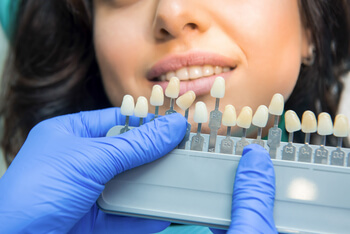Are you considering composite veneers as an option for your discoloured teeth? Or are composite veneers the right option for fixing multiple teeth issues? The cost of composite veneers can vary depending on several factors. This blog post highlights some of the important factors affecting the cost of composite veneers. We will also discuss the pros and cons of choosing composite veneers over porcelain veneers, the resin material used for composite veneers, and the comparison between direct and indirect composite veneers.

What are Composite Veneers?
Composite veneers or resin veneers are thin layers of composite resin material bonded to the front surface of your natural teeth to improve their appearance.
Composite veneers are an affordable option for reshaping and whitening your teeth. They provide an excellent alternative to porcelain veneers, which can be much more expensive.
Additionally, composite veneers offer several significant benefits, including flexibility, durability, and matching the colour and shade of your natural teeth.
Benefits of Composite Veneers
Cost-Effective
Composite veneers are a budget-friendly option for improving the appearance of your teeth. Unlike porcelain veneers, composite veneers require minimal tooth preparation, which means the cost is significantly lower.
Quick and Easy
Composite veneers can be completed in just one visit to the dentist. After the initial consultation, the dentist can apply the veneers directly to your teeth, reshaping them as necessary and giving you a bright and even smile in just a few hours.
Versatile
Composite veneers can address various cosmetic dental issues, including discoloured teeth, small gaps, chips, and cracks. They can even be used to correct minor misalignments.
Reversible
Unlike traditional porcelain veneers, composite veneers can be easily removed if you wish to change your mind. This makes them a less permanent option and gives you the flexibility to change your smile as needed.
Natural-Looking
Composite veneers are made of a tooth-coloured resin that is moulded and shaped to match the natural contours of your teeth. Unlike porcelain veneers, they can be seamlessly blended with your natural teeth for a more natural-looking result.
No Downtime
Because composite veneers require minimal tooth preparation, there is no recovery time. You can return to your daily activities immediately after the procedure.
Long-Lasting
With proper care, composite veneers can last up to 10 years or more. Brushing and flossing regularly and avoiding chewing on hard or sticky foods can help extend the life of your veneers.
Stain-Resistant
Composite veneers are stain-resistant, meaning they won’t discolour over time like natural teeth. However, avoiding foods and drinks known to cause staining, such as coffee, tea, and red wine, is still important.
Improves Confidence
Composite veneers can significantly improve the appearance of your teeth, giving you a brighter and more even smile. This can boost your self-confidence and help you feel more comfortable in social situations.

Minimal Sensitivity
Unlike traditional porcelain veneers, composite veneers are less likely to cause tooth sensitivity or discomfort.
This is because they require less tooth preparation and don’t cover as much of the tooth surface.
Easy Maintenance
Composite veneers are easy to maintain with regular brushing and flossing, just like natural teeth.
Regular dental checkups and cleanings can also help keep your veneers in good condition.
Customisable
Composite veneers can be customised to match your unique smile goals and preferences. Your dentist can work with you to choose the right shape, size, and colour of veneers to enhance your natural beauty.
Less Risk of Chipping
Because composite veneers are made of a flexible resin material, they are less likely to chip or crack than porcelain veneers. This makes them a good option for people with an active lifestyle or who grind their teeth.
Local Anaesthesia Not Required
In most cases, composite veneers can be applied without local anaesthesia. This means you won’t have to deal with the numbness or discomfort of injections, making the procedure more comfortable and less stressful.
Types of Veneers
Porcelain Veneers
Porcelain veneers are the most popular type because of their long-lasting nature. They are made of porcelain and are, therefore, incredibly strong. Porcelain veneers are used extensively to fix multiple teeth and create the perfect smile. Porcelain veneers are highly recommended when the teeth must be reshaped or resized to fit the patient’s face. They can last more than a decade but are also hard to repair once damaged.
Direct Composite Veneers
Direct composite veneers are a type of composite resin veneers that are shaped directly on the affected natural tooth. A cosmetic dentist gradually applies the composite bonding material in stages for reshaping and rebonding the damaged tooth. Direct composite veneers are perfect for those without significant intervention and offer a quick and cost-effective solution for cosmetic problems.
Indirect Composite Veneers
Indirect composite veneers are resin veneers pre-made by dental laboratories before being attached to the patient’s tooth. They often reinforce the strength of natural teeth that are chipped or broken. This type of veneer primarily serves a functional purpose, though it can also improve the aesthetics of stained teeth.

Factors that Affect the Cost of Composite Veneers
Composite veneers are made of composite resin, a tooth-coloured material that mimics the natural tooth.
Unlike porcelain veneers, which must be fabricated in a dental lab, composite veneers are made directly in the dental clinic.
As a result, they are much cheaper than porcelain veneers.
On average, composite veneers cost around $400 per tooth. Porcelain veneers, on the other hand, cost around $925 per tooth.
With composite veneers, you can get the same aesthetic result at a fraction of the cost.
Materials Used
Composite veneers are composite resin, a tooth-coloured material applied to natural teeth’ front surface. Composite resin is more affordable compared to porcelain material. Hence composite veneers cost less than porcelain veneers. Because composite resin is cheaper, it may be more prone to staining and wear and tear over time. However, with proper care, composite veneers can last 5-7 years before needing replacement.
Lab Fees
Composite veneers only sometimes require the services of a dental lab, as they can be applied directly to the tooth by the cosmetic dentist. This reduces the overall cost of composite veneers, making them a more cost-effective option for those looking to enhance their smile.
Location
The location of the dental clinic can impact the price of composite veneers. Higher-income areas may have higher costs due to the higher cost of living, while clinics in less expensive areas may offer more affordable prices. The clinic’s location is important when looking for a cosmetic dentist to perform the procedure.
Dentist’s Expertise
The expertise of the cosmetic dentist is another factor that can impact the cost of composite veneers. A highly skilled and experienced cosmetic dentist with a good reputation may charge more than a less experienced dentist. However, it’s important to prioritise the quality of work over cost when choosing a dentist to perform the procedure.
Number of Teeth to Be Treated
The total cost of composite veneers also depends on the number of teeth that need to be treated. Treating a single tooth will cost less than treating multiple teeth, as additional materials and labour will be required for multiple teeth. It’s important to discuss with your dentist the number of teeth you want to treat and to get an accurate estimate of the overall cost of the procedure.
Average Cost Range of Composite Veneers in Different Countries

Australia
Composite veneers cost around AUD 250 per tooth in Australia.
The actual price will depend on whether it is a direct or indirect composite veneer, how many teeth are involved, and the complexity of the treatment.
Dental clinics in Australia are known for using only high-quality composite resin material that is safe for your natural teeth.
They have cosmetic dentists who are well-trained in the latest techniques of composite veneers, and you can trust them to give you a smile that looks as natural as your teeth.
Malaysia
Malaysia is a popular destination for medical tourism, including dental treatments. The price range for composite veneers in Malaysia is around MYR 400 per tooth. However, it is important to note that the quality of the composite resin and the dental expertise may be lower than what you can find in Australia. Additionally, the travel and accommodation expenses may add to the total cost of your smile makeover.
India
The cost of composite veneers in India is relatively lower than in Australia or Malaysia, starting from INR 1000 per tooth. While many dental clinics in India offer composite bonding, you should be cautious in selecting a reputable cosmetic dentist who can match the shade and shape of the veneers to your natural teeth. The resin material in your veneer should be safe for oral health and durable enough to withstand daily wear and tear.
Thailand
Thailand is another popular destination for dental tourism. The average price range for composite veneers in Thailand is around THB 6000 per tooth. While the cost may be tempting, it is important to consider the quality of dental clinics in Thailand. Some may use inferior resin material that may pose risks to your natural teeth or cause early veneer failure. Finding an English-speaking dentist in certain areas of Thailand may also be challenging.
Why opt for Australia? While the cost of composite veneers may be slightly higher in Australia than in the other countries mentioned, it is worthwhile to invest in safe and long-lasting, high-quality cosmetic dentistry. You will also have peace of mind knowing that the dental clinic follows strict hygiene and safety protocols. Moreover, you can discuss your treatment plan and expectations with the cosmetic dentist overseeing your smile makeover. Lastly, you can stay in your own country and avoid the hassles of travelling abroad for dental treatments.
Conclusion
Composite veneers are a popular cosmetic dental treatment that offers an affordable alternative to porcelain veneers. They provide excellent results for patients who want an aesthetically enhanced smile. However, the cost of composite veneers depends on several factors, including the number of teeth that need treatment, the cosmetic dentist’s experience, the location, and the level of customisation. Patients should be aware of the pros and cons of composite veneers and compare them to alternatives such as porcelain veneers. Consulting our reputable cosmetic dentists at Infinity Dental Care can help you decide if composite veneers are the right option for your dental needs. Contact us today on (02) 9159 6237 to schedule your first appointment!
References
Smile makeover with direct composite veneers
https://www.ncbi.nlm.nih.gov/pmc/articles/PMC6076883/
Direct composite veneers – an aesthetic alternative
https://www.ncbi.nlm.nih.gov/pmc/articles/PMC6076883/

